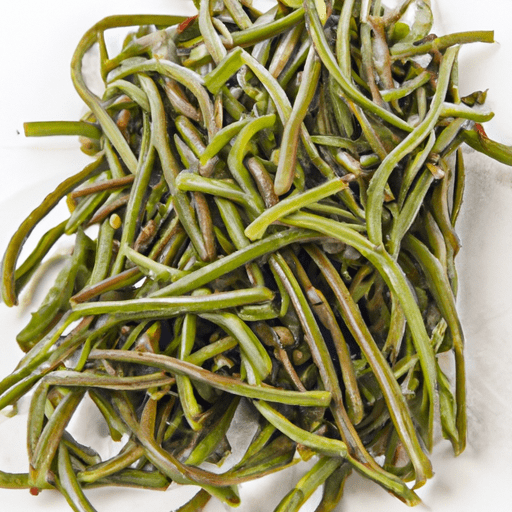The Delightful World of Dilly Beans
If you’re a fan of pickles and looking for a new twist on the classic, look no further than dilly beans. These tangy and crunchy treats are a true delight for pickle enthusiasts and offer a unique flavor profile that sets them apart. In this blog post, we’ll dive into the world of dilly beans, exploring their taste, common uses in cooking, nutritional value, and uncovering a few interesting historical tidbits. So, let’s get pickling!
The Taste of Tangy Perfection
Dilly beans, also known as pickled green beans, are like a burst of sunshine on your taste buds. Their tangy flavor comes from the combination of vinegar, garlic, and a blend of spices that gives dilly beans a deliciously complex taste. The beans themselves retain their crispness, providing a satisfying crunch with each bite. The sharpness of the vinegar is balanced with the earthiness of the green beans, making them a perfectly balanced snack or accompaniment to a meal.
Versatile in the Kitchen
Dilly beans are incredibly versatile and can be used in various culinary creations. Here are a few popular ways to enjoy them:
Straight from the Jar: Dilly beans are a fantastic snack on their own. Their tanginess and crunch make them the perfect satisfying bite whenever a pickle craving strikes.
Charcuterie and Cheese Platters: Add a jar of dilly beans to your next charcuterie board or cheese platter for an extra pop of color, texture, and flavor. The acidity of the beans provides a refreshing contrast to the richness of cheeses and cured meats.
Garnish and Condiment: Dilly beans can be sliced and used as a vibrant garnish in salads, sandwiches, and burgers. You can even chop them up to create a zesty relish or blend them into a homemade salsa for added depth.
Cocktail Accent: Upgrade your favorite cocktails by using dilly beans as a garnish. Their tangy kick pairs exceptionally well with the subtle heat of a Bloody Mary or the herbal notes of a gin and tonic.
Nutritional Value
Dilly beans not only offer an excellent taste experience but are also packed with nutritional goodness. They’re low in calories and fat while being a great source of fiber and vitamins. Green beans are rich in Vitamin C, Vitamin K, Vitamin A, and folate, making dilly beans a delightful way to enjoy a healthy snack that doesn’t skimp on flavor.
A Glimpse into History
While the exact origins of dilly beans remain somewhat elusive, the art of preserving green beans in vinegar and spices has roots in traditional canning practices. Pickling vegetables has long been an effective method of preservation, allowing people to enjoy the taste of summer’s bounty throughout the year. Dilly beans, with their vibrant green color and tangy flavor, became a beloved staple on kitchen shelves, especially in North America.
Get Pickling!
Ready to embark on a dilly bean adventure? You can find dilly beans in some grocery stores or farmers markets, but why not try your hand at making a batch at home? The process is surprisingly simple and rewarding. From selecting fresh green beans to sterilizing jars and preparing your own pickling brine, creating homemade dilly beans is an enjoyable project that will leave you with awe-inspiring results.
So, go ahead, grab a jar of dilly beans or roll up your sleeves and start pickling! This unique snack will not only elevate your culinary creations but also provide you with a tangy, crunchy pickle experience like no other.
Dilly Beans
Origin: Dilly beans, also known as pickled green beans, are a traditional American dish that originated in the Northeastern region of the United States.
Common Uses: Dilly beans are typically made by pickling young, tender green beans in a brine composed of vinegar, water, salt, and herbs. The pickling process preserves the beans and imparts a tangy, dill flavor. They can be enjoyed as a snack on their own, added to salads or antipasto platters, or used as a garnish for cocktails.
Nutritional Benefits: Dilly beans are low in calories and fat, making them a healthy snack option. They are a good source of fiber, vitamin C, and vitamin K. The fermentation process involved in pickling the beans may also enhance their probiotic content, which can be beneficial for gut health.
Unique Properties: The tangy flavor of dilly beans comes from dill seeds and fresh dill weed, which are added during the pickling process. The pickling brine also often contains garlic, red pepper flakes, mustard seeds, or other spices to provide additional flavor. The crunchy texture of the green beans adds to their appeal.
Historical Significance: The tradition of pickling green beans has roots in preserving the summer harvest for the winter months, dating back to the early settlers in America. The practice allowed people to enjoy the flavors of fresh vegetables throughout the year when garden-fresh produce was not readily available. Today, dilly beans are still enjoyed as a popular homemade or store-bought pickled treat.




Use the share button below if you liked it.
It makes me smile, when I see it.